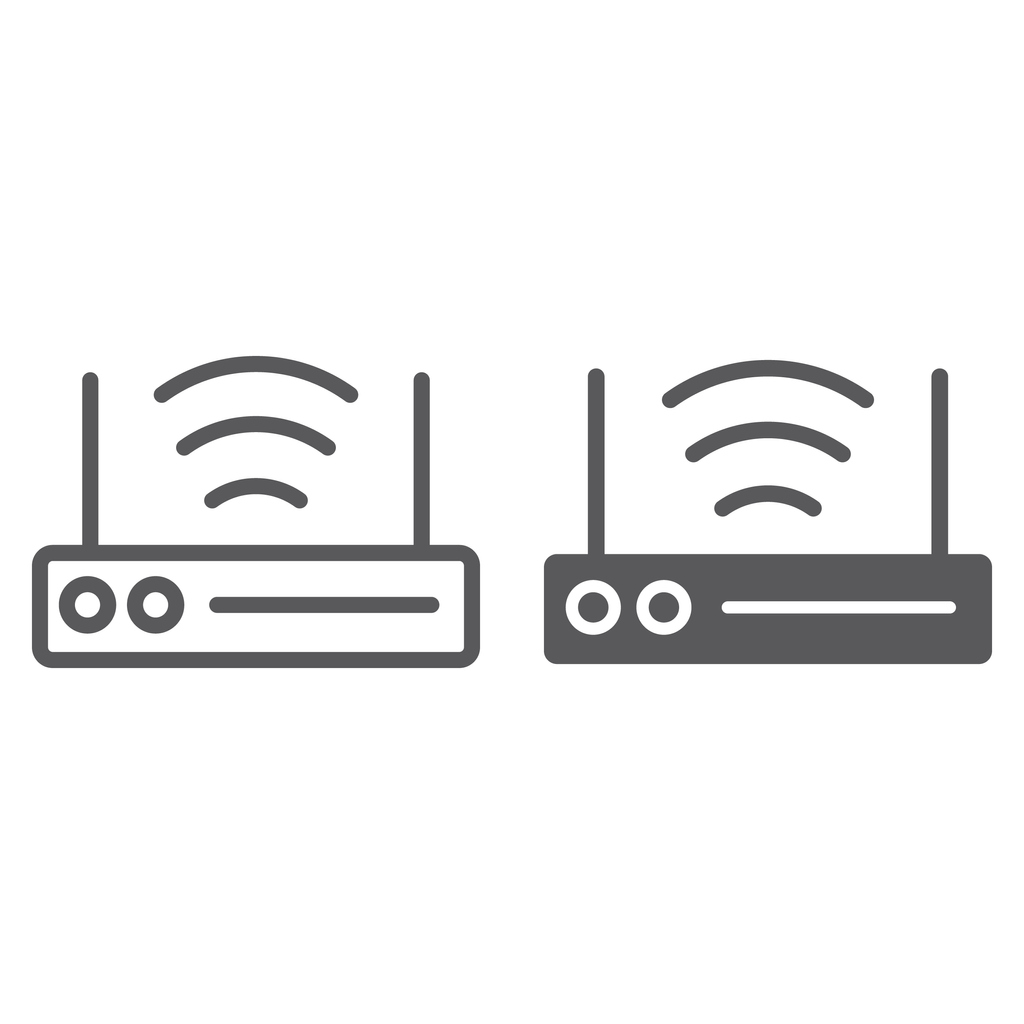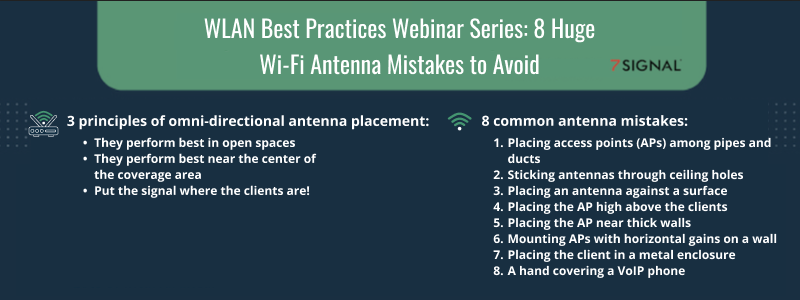
Blog
WLAN Best Practices Webinar Series: 8 Huge Wi-Fi Antenna Mistakes to Avoid
Access point and antenna placement can have a significant impact on Wi-Fi performance. Here are 8 common mistakes network planners make.

Successful WLANs depend on many moving parts, and Wi-Fi antenna issues may be the root cause of some performance impairments. Addressing these problems requires understanding what gets in the way of signals based on where you place APs and antennas.
Here is an overview of the sources of interference and eight common antenna mistakes and their impact on Wi-Fi:
The principles of omni-directional antenna placements
First, let’s talk about best practices for omni-directional antenna placement. These three principles help you more effectively plan a network:
- Omni-directional antennas perform best in open spaces — make sure they’re clear of walls and obstructions.
- Omni-directional antennas perform best near the center of their intended coverage area. Don’t offset them in a corner of the room, for example.
- Put the signal where the clients are. The signal doesn’t do much if you're covering spaces with no clients. Think about where people will congregate, like conference rooms or auditoriums.
These placement principles will get you started with antenna planning. Walk through them whenever you’re considering where to secure APs.
The main sources of antenna interference
So, how do antennas end up causing interference? Here are the main categories that violate the above principles and get in the way of clean multidirectional patterns:
- Detuning the antenna: A detuned antenna occurs when there is an object nearby, particularly something conductive, that changes the frequency of the antenna. Ensure there aren't objects within 5 inches for the 2.4 GHz band and 3 inches for 5 GHz.
- Signal reflection and pattern changes: Conductive objects within 2 feet with 2.4 GHz and 15 inches with 5 GHz can reflect the signal and change its pattern.
- Wasted signal: The signal will be wasted if the antenna coverage area includes areas where there are no client devices.
- Signal not at client: This problem occurs when the antenna coverage area doesn’t include the intended client area.
- Increased self-interference: Self-interference happens when access points can hear each other better than the clients will hear them, leading to more interference.
- Obstructions: You'll have an obstruction when large, usually metallic or dense objects between the AP and the client reflect or absorb the signal.
Without the correct AP and antenna placement strategy, you'll run into these issues repeatedly. Next, let’s dig into the most common mistakes that cause these problems.
8 antenna placement mistakes to avoid
1. Placing APs among pipes and ducts
APs placed in the ceiling among metal air ducts, grids, and large lamp reflectors cause the signal to face a lot of reflection and obstruction, and those conductive objects in close proximity will detune the antenna.
Multiple reflections and refractions lead to several copies of the signal arriving at receivers, which drops data rates. Signal strength suffers at both ends when radio waves reflect in random directions. It’s much better to bring APs down below the ceiling grid.
2. Sticking antennas through ceiling holes
Another way an antenna will get detuned is if you have the AP in the ceiling and stick the dipole antennas through small holes in a metal ceiling panel, an AP cover, or a metal grid. Part of the energy will be directed upward, creating a messy signal.
3. Placing an antenna against a surface
It’s not effective for antennas to be pushed up against a surface, like a wall, where the AP is mounted. The antenna detunes to another frequency, and the radiation pattern and impedance matching alter at the target operating frequency. You’ll also experience wasted signal with this mistake.
4. Placing high-gain antennas high above the clients
If you’re putting the signal up in a very tall ceiling, it's more wasted coverage — you’re not covering where the clients actually are. The APs also hear each other very well since they’re together up high, increasing self-interference. They have antennas with narrow beams pointing sideways, so overshooting and additional co-channel interference will occur.
Those APs will also respond to all the probes of every device that travels by. This is a challenge in big public spaces since APs could be getting hundreds of probes a minute from devices.
Instead, you can hang APs from conduit in very high-ceiling buildings or mount APs on the wall using directional antennas.
5. Placing APs near thick or outside walls
When APs with omni-directional antennas are positioned next to a thick wall, half of an antenna’s coverage pattern is lost. This is because it tries to pick up signals from the wall, which is in an unused direction. Thus, a lot of wasted signal just fires into the wall.
6. Mounting APs with horizontal gain on a wall
Instead of mounting APs with sideways gain patterns on the ceiling — where they were designed to be installed — mounting them on the wall will cause the gain to go up and down, amplifying interference and decreasing signal levels. This mistake also leads to wasted coverage and a signal that’s not where the clients are.
7. Placing the client (or AP) in a metal enclosure
When clients like laptops are placed in a metal enclosure or a cart, it leads to antenna detuning and obstruction. The proximity of the conductive metal means the energy won’t be able to radiate outside the box.
8. A hand covering a Wi-Fi VoIP phone
This is more of a planning and surveying issue rather than an AP or antenna placement issue. Some network planners forget that VoIP terminals, such as smartphones, are often placed against the human head with a hand covering the other side. This can obstruct the signal. Site surveys with a laptop card and appropriate standard limits can provide completely different results.
Identify antenna issues with better Wi-Fi monitoring
Proper antenna (and AP) placement is crucial to a high-performing WLAN. And part of effective network planning, troubleshooting, and improvement is detailed wireless experience monitoring. The 24/7, client-level visibility provided by 7SIGNAL’s Mobile Eye® and Sapphire Eye® sensors identifies the root causes of issues, whether interference, AP placement, antenna configuration, congestion, or something else. The platforms’ detailed, real-time reporting on hundreds of KPIs can even identify and help solve issues before end-users notice.
Contact the 7SIGNAL team today to learn more about how our monitoring solutions enhance Wi-Fi experiences.
7SIGNAL® is the leader in wireless experience monitoring, providing insight into wireless networks and control over Wi-Fi performance so businesses and organizations can thrive. Our cloud-based wireless network monitoring platform continually tests and measures Wi-Fi performance at the edges of the network, enabling fast solutions to digital experience issues and stronger connections for mission-critical users, devices, and applications. Learn more at www.7signal.com.